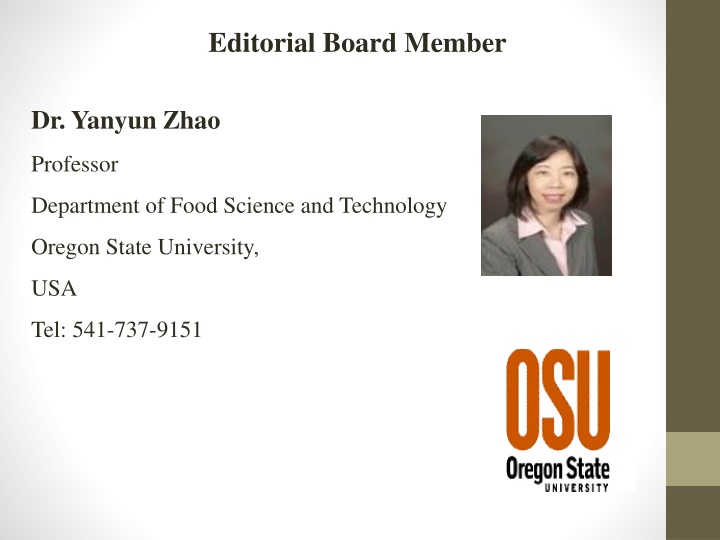Dr. Yanyun Zhao - Food Science & Technology Professor at Oregon State University
Dr. Yanyun Zhao is a prominent Professor at Oregon State University specializing in food science and technology. With a strong research focus on food processing technologies and food safety, Dr. Zhao has made significant contributions to the field. Her expertise in value-added food processing, antimicrobial coatings, and novel food processing approaches has led to the development of strategies to enhance food quality and safety. Through her publications and edited books, Dr. Zhao continues to advance the understanding of food science and its impact on public health.
Download Presentation

Please find below an Image/Link to download the presentation.
The content on the website is provided AS IS for your information and personal use only. It may not be sold, licensed, or shared on other websites without obtaining consent from the author.If you encounter any issues during the download, it is possible that the publisher has removed the file from their server.
You are allowed to download the files provided on this website for personal or commercial use, subject to the condition that they are used lawfully. All files are the property of their respective owners.
The content on the website is provided AS IS for your information and personal use only. It may not be sold, licensed, or shared on other websites without obtaining consent from the author.
E N D
Presentation Transcript
Editorial Board Member Dr. Yanyun Zhao Professor Department of Food Science and Technology Oregon State University, USA Tel: 541-737-9151
Biography Yanyun Zhao is a Professor in the Department of Food Science & Technology, Oregon State University (OSU) with combined research, Extension and education responsibilities in value- added food processing. She received her BS and MS from University of Shanghai for Science and Technology (former Shanghai Institute of Mechanical Engineering) in 1982 and 1987, respectively, and PhD from Louisiana State University in 1993. She then joined Iowa State University as a Post-Doctoral Research Associate (1993-1995) and an Assistant Professor (1995-1996).
Research Interest Investigation of the Impacts of Different Food Processing and Packaging Technologies on the Physiochemical, Nutritional and Microbial Qualities of Foods and Development of Strategies to Retain Food Quality and Enhance Food Safety. Development of Antimicrobial Edible Coatings for Enhancing Quality and Safety of Fresh Produce and Processed Foods. Development of Novel Food Processing Approaches to Develop Value-Added Food Products.
Publications Deng, Y., Yang, G., Yue, J., Qian, B., Liu, Z., Wang, D., Zhong, Yu and Zhao, Y. 2014. Influences of ripening stages and extracting solvents on the polyphenolic compounds, antimicrobial and antioxidant activities of blueberry leaf extracts, Food Control, In Press. Deng, Y., Wang, Y., Yue, J., Zhong, Yu and Zhao, Y. 2014. Thermal Behavior, Microstructure and Protein Quality of Squid Fillets Dried by Far-Infrared Assisted Heat Pump Drying. Food Control. 36(1), 102-110. Jung, J. and Zhao, Y. 2013. Impact of the structural differences between - and -chitin on the depolymerizing reaction and antibacterial activity of - and -chitosan. J. Agric. Food Chem. 61(37) 8783-8789. Zhao, Y., Lian, Z, and Yue, Jin. 2013. Recent Development in Food Packaging, Invited review article. Journal of Chinese Institute of Food Science and Technology, 13(4), 1-10.
Books Zhao Y. Editor. 2012. Specialty foods: processing technology, quality, and safety. Taylor and Francis Group, LLC, Boca Raton, FL. ISBN-10: 1439854238. Zhao Y. Editor. 2007. Berry fruits: Value-added products for health promotion. Taylor and Francis Group, LLC, Boca Raton, FL. ISBN-10: 0849358027.
Food Safety Food safety a scientific discipline describing handling, preparation, and storage of food in ways that prevent foodborne illness. Food can transmit disease from person to person as well as serve as a growth medium for bacteria that can cause food poisoning.
Importance of Food Rheology Food rheology is important in quality control during food manufacture and processing Long food can be stored The study of food rheology is more complicated than study in fields such as the rheology of polymers.
Rheology in Daily Life We normally take for granted a lot of things in life and these include some of the rheological events . The pictures show the different roles of rheology in food and nonfood products.
Examples of Rheological Properties Viscosity Elasticity Peanut butter in the jar Ketchup is commonly used an example The textural properties of a peanut butter and jelly sandwich
Rheological and Functional Properties in Cheese Cheese Cheese is a nutritious Food made mostly from Cow s milk. Curded by Lactic Acid Bacteria It is a source of protein and calcium Containing additional nutrients Types of Cheese Asiago Cheese Bleu Cheese Goat Cheese Cream Cheese Vegetarian Cheese
Rheological Tests Three categories Empirical- supply basic single point information Imitative-try to imitate the forces and deformations associated with a specific process Fundamental- gives information as to the element properties of a material
Rheological Methods Small Strain Used to define both the elastic and the viscous nature of cheese. Cheese is a time dependent material Useful in understanding mechanisms of some endues functions. Used to determine changes caused by processing and storage parameters of cheeses Large Strain Used to determine cheese texture These measurements occur outside of linear viscoelastic region Characterize the non linear and fracture properties of the material Relate well to sensory properties since mastication is a large strain action
Factors affecting Rheological and Functional Properties Can be categorized as below Properties of milk Cheese composition Cheese making procedures Post manufacturing processes
Industrial Aspect of Rheology Responsible for any formulation, production, appearance, usage, and finally affect stability Affects final cost of product If a material is pumped, sprayed, extended, extruded, molded, coated, mixed, chewed, swallowed, rubbed, transported, stored, heated, cooled, aged Rheology is important
Examples of Complex Fluids Foods Emulsions (mayonnaise, ice cream) Foams (ice cream, whipped cream) Suspensions (mustard, chocolate) Gels (cheese) Bio fluids Suspension (blood) Gel (mucin) Solutions (spittle), etc.,
Thank You..! Thank You..!























